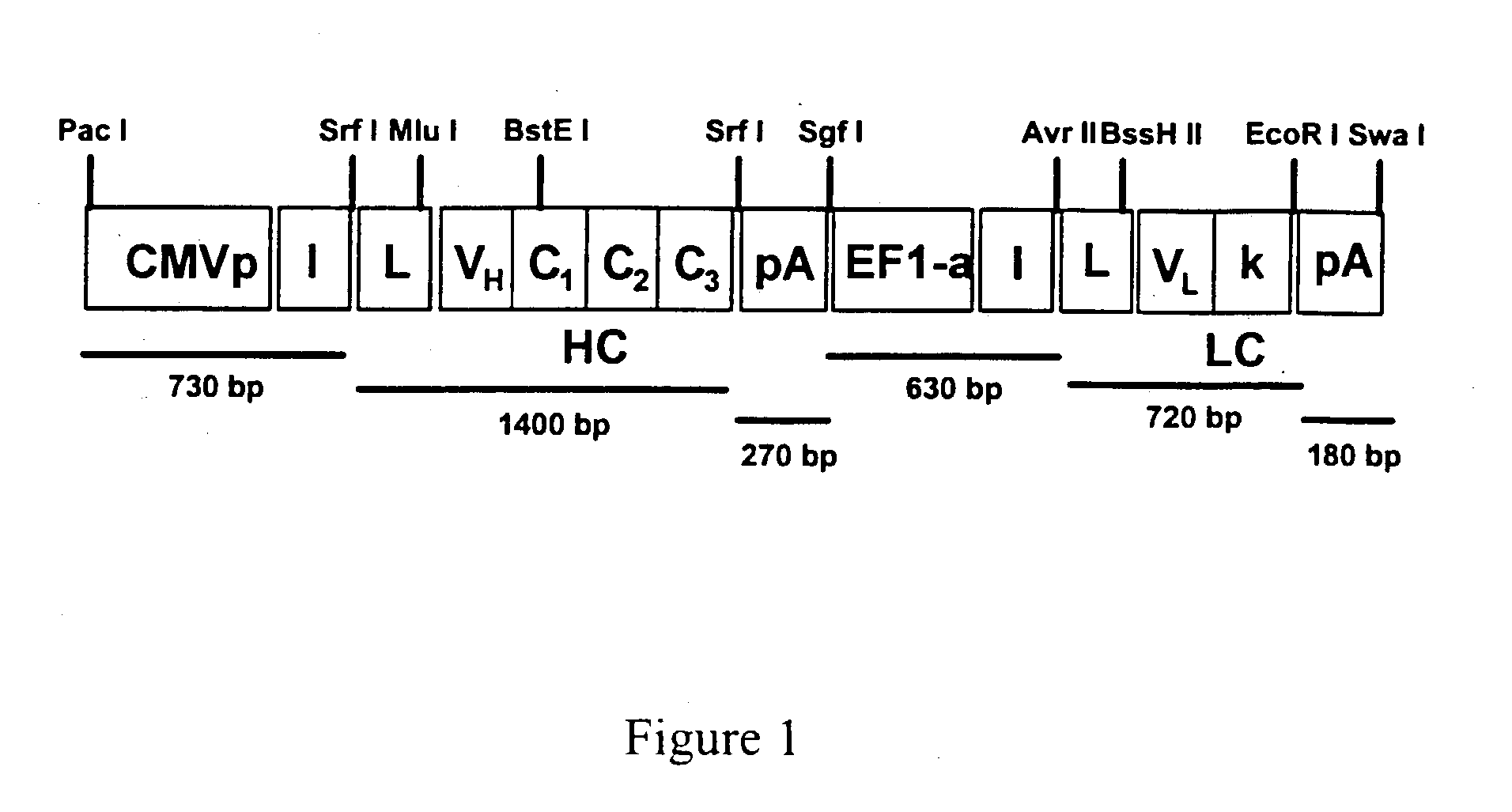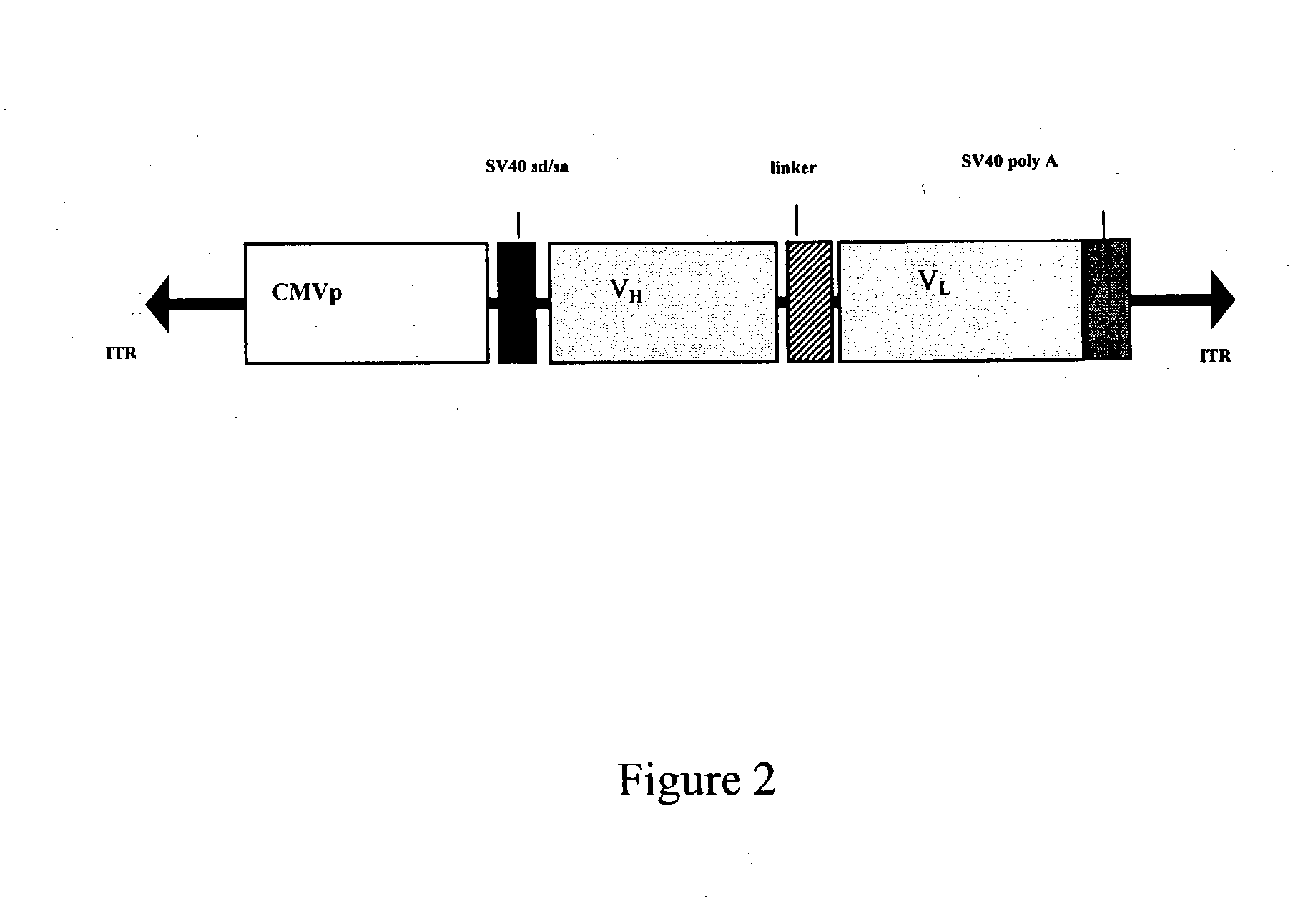Antibody gene transfer and recombinant AAV therefor
a technology of aav and aav, which is applied in the field of antibody gene transfer and recombinant aav therefor, can solve the problems of aav-infected cells not being resistant to superinfection, slow progression to disease, and toxic treatment regimens, so as to prevent progression, slow the progression, and increase the number of cd4-positive t cells
- Summary
- Abstract
- Description
- Claims
- Application Information
AI Technical Summary
Benefits of technology
Problems solved by technology
Method used
Image
Examples
example 1
Construction of a Dual Promoter rAAV for Antibody Expression
[0047] To achieve efficient antibody expression within target muscle cells, a dual promoter rAAV was constructed that resulted in optimal co-expression of heavy and light chain proteins within the same transduced cell. As shown in FIG. 1, the resulting dual promoter rAVV had the following features: (1) two constitutive promoters that are active in skeletal muscle in the context of a rAAV vector (hCMV promoter / enhancer and the human EF1-alpha promoter); (2) several unique 8 basepair restriction enzyme sites incorporated into the vector to allow for the rapid replacement of promotor elements or heavy and light chain coding sequences; (3) site-directed mutagenesis was performed on the heavy and light chain leader peptide sequences of IgG1b12 to introduce unique restriction sites (Mlu I for the heavy chain leader and BssH II for the light chain leader) that facilitate in-frame antibody gene cloning; (4) the IgG1b12 heavy chain ...
example 2
rAAV Production
[0054] rAAV / IgG1b12 was produced and purified using methods known in the art (Clark et al., Hum. Gene Therapy 10: 1031-1039, 1999; Clark et al., Hum. Gene Therapy 6: 1329-1341, 1995). Briefly, a producer cell line (CE71) was isolated following HeLa cell transfection with plasmid pAAV / IgG1b12 / rep-cap / neotk and subsequent G418 (700 .mu.g / ml) drug selection. Two hundred individual cell lines were screened following wild-type adenovirus type 5 infection (moi=20) and CE71 was identified as producing the highest DNase resistant particles (DRP) per cell (10.sup.4 DRP / cell). For large scale vector production, 10.sup.10 CE71 cells were expanded in a Corning Cell Cube adherent cell bioreactor and subsequently infected with wild-type Ad 5 (moi=20). Following development of adenovirus CPE (72 hr), rAAV / IgG1b12 was purified from the crude CE71 cell lysate using heparin chromatography as previously detailed (Clark et al., Hum. Gene Therapy 10: 1031-1039, 1999). DRP titers were dete...
example 3
Production of Circulating IgG.sub.1 in rAAV Transduced Mice
[0056] Immunodeficient Rag1 mice were inoculated with rAAV / IgG1b12 into both quadriceps muscles. Rag1 mice were used to avoid an anti-human IgG response.
[0057] All experiments were conducted in accordance with the Children's Hospital Institutional Animal Care and Use Committee. Six week old Rag-1 mice (C.129S7(B6)-Rag1.sup.tm / Mom) were purchased from The Jackson Laboratory (Bar Harbor, Me.) and housed in microisolator barrier housing. The study consisted of 16 animals: 6 received 5.times.10.sup.11 DNase resistant particles (DRP) of rAAV / IgG1b12; 6 received 5.times.10.sup.10 DRP; 2 received an irrelevant rAAV vector expressing .beta.-glucuronidase (rAAV / GUS, 4.times.10.sup.11 DRP); and, 2 were given PBS diluent (used for vector DNA analysis only).
[0058] Mice were anesthetized with intramuscular injection of tiletamine HCl / zolezapam HCl (Telazol, Ft. Dodge, Iowa). A 5 mm skin incision was made over the distal femur and 50 .mu....
PUM
| Property | Measurement | Unit |
|---|---|---|
| pH | aaaaa | aaaaa |
| composition | aaaaa | aaaaa |
| length | aaaaa | aaaaa |
Abstract
Description
Claims
Application Information
 Login to View More
Login to View More - R&D
- Intellectual Property
- Life Sciences
- Materials
- Tech Scout
- Unparalleled Data Quality
- Higher Quality Content
- 60% Fewer Hallucinations
Browse by: Latest US Patents, China's latest patents, Technical Efficacy Thesaurus, Application Domain, Technology Topic, Popular Technical Reports.
© 2025 PatSnap. All rights reserved.Legal|Privacy policy|Modern Slavery Act Transparency Statement|Sitemap|About US| Contact US: help@patsnap.com


